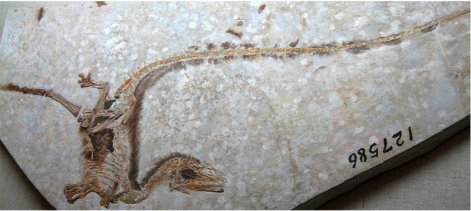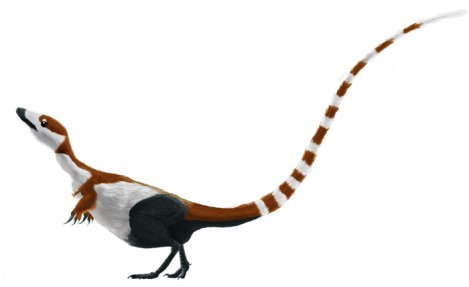
In 1996, a farmer and part-time fossil hunter in the Liaoning Province of China found a fossil that he recognized was rather unique. It had all the hallmarks of a dinosaur, but it had some “fuzz” on the head, neck, back and tail that looked like hair or feathers. Over the years, two distinct interpretations of this “fuzz” have emerged. Some scientists, like world-renowned paleornithologist Dr. Alan Feduccia, considers it to be nothing more than collagen fibers that remain from skin structures such as frills. Others, like paleontologist Dr. Mike Benton, think it is the remains of “protofeathers,” an evolutionary precusor to bird feathers. Given the current “birds evolved from dinosaurs” craze, you can guess which view is held by the majority of those who have studied the fossil.
Of course, science is not done by majority vote. It is done by examining the data. So what do the data say about this “fuzz?” Well, in 2007, Feduccia and some colleagues published a study in the Proceedings of the Royal Society B. In that study, they examined the detailed structure of the “fuzz.” They showed that its structure is exactly what you would expect for protein fibers that would be used to stiffen a system of frills. In addition, they say:1
The fibres show a striking similarity to the structure and levels of organization of dermal collagen. The proposal that these fibres are protofeathers is dismissed.
Of course, that’s not the end of the story.
In 2010, Benton and colleagues published a study in the journal Nature. In that study, they claimed to have found melanosomes (pigment-producing organelles) in the “fuzz.” In addition, they say that these melanosomes are nearly identical to what is found in the preserved feathers of early birds. They conclude that these results refute the claims that the “fuzz” is the remains of collagen fibers. Instead, the results show that it is the remains of protofeathers and:2
Furthermore, the data here provide empirical evidence for reconstructing the colours and colour patterning of these extinct birds and theropod dinosaurs: for example, the dark-coloured stripes on the tail of the theropod dinosaur Sinosauropteryx can reasonably be inferred to have exhibited chestnut to reddish-brown tones.
Since they published their results, some scientific illustrators have gone crazy, producing “reconstructions” of Sinosauropteryx that look like the one below:

The problem is that Benton’s conclusions are most likely wrong. As a result, reconstructions such as the one given above are, at best, fanciful. How do we know that Benton’s study is probably wrong? Theagarten Lingham-Soliar, a colleague of Feduccia, has evaluated Beton’s work and has found that its conclusions were based on an optical illusion as well as an inaccurate estimation of the size of the structures that were identified as melanosomes. In addition, his microanalysis shows that the “fuzz” has bead-like structures of the same shape and size as certain bands of collagen found in skin. He says:3
While feathers in birds and some non-avian dinosaurs may be correctly identified by melanosomes, in others, specifically in Sinosauropteryx, they are almost certainly not. Zhang et al.’s (2010) study does nothing to detract from previous conclusions based on a number of lines of evidence that the filamentous structures were in all probability collagenous. [internal references removed for clarity]
Is this debate over? Certainly not. However, I think that at this point, there are two “take-home messages.” First, when you read about “feathered dinosaurs,” remember that their existence is very much an open question. There are many experts who claim that they existed. There are other equally-qualified experts who say there is no strong evidence for their existence. Based on my non-expert reading of the literature, it seems to me that those who say there is no strong evidence for feathered dinosaurs have the best arguments. Second, whenever you see a “reconstruction” of a fossil, take it with a grain of salt. Even when reconstructions (such as the one given above) are based on evidence, it is often later shown that the evidence used is incorrect.
REFERENCES
1. Theagarten Lingham-Soliar, Alan Feduccia, and Xiaolin Wang, “A new Chinese specimen indicates that ‘protofeathers’ in the Early Cretaceous theropod dinosaur Sinosauropteryx are degraded collagen fibres,” Proceedings of the Royal Society B 274:1823-1829, 2007
Return to Text
2. Zang F, Kearns SL, Orr PJ, Benton MJ, Zhou Z, Johnson D, Xu X, and Wang X, “Fossilized melanosomes and the colour of Cretaceous dinosaurs and birds,” Nature 463:1075-1078, 2010
Return to Text
3. Theagarten Lingham-Soliar, “The evolution of the feather: Sinosauropteryx, a colourful tail,” Journal of Ornithology 152(3):567-577, 2011
Return to Text

Dr. Wile, I also noticed in the photo that the Sinosauropteryx appears to be in the opisthotonic pose mentioned in one of your previous posts (http://blog.drwile.com/?p=7118).
Also, the Wikipedia page on the Yixian formation of China from which the Sinosauropteryx fossil was taken shows that mammals with impressions of fur and soft tissue have been found in the same formation (http://en.wikipedia.org/wiki/Paleobiota_of_the_Yixian_Formation). An interesting test of the dinofuzz theory might be to test the mammal fossils for collagen and compare the results with those of Sinosauropteryx.
That’s an excellent thought, J.S. I hope someone does that.
Now that I’ve thought about your suggestion, J.S., I see one problem. If the “fuzz” in the dinosaur fossil is collagen, it is there because it was the support protein for frills. Mammals aren’t known to have frills, so I am not sure if a direct comparison could be made. However, I would think it would most certainly be worth looking into.
Dr. Wile, I read the Zang et al. (2010) article you cited, and saw that they had compared Sinosauropteryx melanosomes with degraded feather material from Confuciusornis, a true bird also found in the Yixian formation, going to lengths to prove that the materials were organic and not chemical or diagenetic. In my opinion, the true elephant in the living room here is the presence of biomolecules within fossils presumed to be around 120 million years old, when studies have shown the survival time of organic material should at the most be in the tens of thousands of years.(1)
(1) Christina Nielsen-Marsh, “Biomolecules in fossil remains: Multidisciplinary approach to endurance,” The Biochemist (June 2002): 12-14.
You are right, J.S. Those biomolecules simply shouldn’t be there if the fossils are as old as conventional geology says they are. I have written about that before (here and here), using the same reference!
Another very important paper is Lingham-Soliar T., The evolution of the feather: Sinosauropteryx, life, death, and preservation of an alleged feathered dinosaur, J. Ornithol. 153(3):699–711, 2012 | DOI 10.1007/s10336-011-0787-x. This discusses not only the fact that the collagen was part of a unified structure not independed feathers, but also the “dead dinosaur posture”, attributed to opisthotonus, as mentioned by the other J.S. above (but maybe it’s not according to the research cited by Dr Jay). I wrote about this in ‘Feathered’ dinos: no feathers after all!
Thanks for adding your insight, Dr. Sarfati.